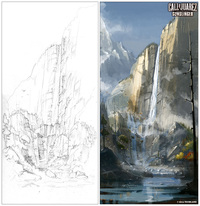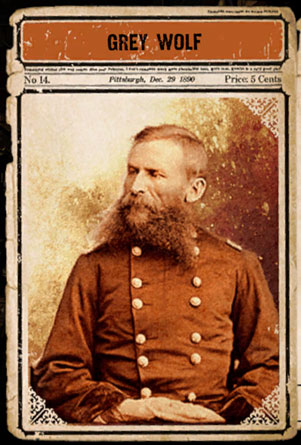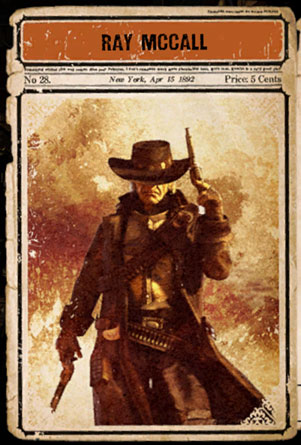Part 6: Last of the Chiricahua

We got bored shooting bandits and lawmen so we’re switching to injuns. Last part felt like it didn’t have a whole lot going on, apart from Hardin, but this one’s pretty packed.
Concept Art


Nuggets of Truth

Native Americans are the indigenous people of North America. They are composed of numerous, distinct Native American tribes, some of which survive to this day as cultural and political entities. According to the accepted theory, migrations of humans from Eurasia to the Americas took place approximately 12,000 years ago via the Bering Land Bridge. Many of these tribes were decimated during the 18th and 19th century as they were pushed out of their homelands by waves of settlers of European origin. As Native Americans were divided into many tribes, some of which were long-standing enemies, they were unable to unite against a common enemy, invaders armed with advanced technology.
L. Frank Baum, the author of the Wizard of Oz, was among the champions of the complete eradication of the remaining Native Americans. He wrote: “(...) The Whites, by law of conquest, by justice of civilization, are masters of the American continent, and the best safety of the frontier settlements will be secured by the total annihilation of the few remaining Indians (...)".
Mere days after the Wounded Knee Massacre, called a ‘battle’ at the time despite being nothing more than a bloodbath inflicted by American soldiers on unarmed men, women and children, L. Frank Baum spoke once again, criticizing the government for not taking even more drastic measures, demanding to “(...) wipe these untamed and untamable creatures from the face of the earth."
Just like the ancient Celts conquered by Romans, Native Americans left an invaluable and rich legacy evident in the language, philosophy, and popular culture of modern day America.

Spotted Elk, also known as Big Foot (Sithanka), was a Miniconjou Lakota Sioux chief who bravely fought the White aggressors. He died, like many of his brothers, on December 29, 1890 in the so-called "battle" known today as the Wounded Knee Massacre.
Cochise of the Chiricahua Apaches, known among his people as A-da-tli-chi, was a war chief who led a long campaign against the United States Army. He evaded capture many times and continued raids against white settlements until 1872. A treaty was negotiated by General Oliver O. Howard and Cochise ended up on a reservation run by his only white friend, Tom Jeffords. He died in 1874 of natural causes and his descendants are said to currently reside at the Mescalero Apache Reservation in New Mexico.
Goyathlay was Cochise's successor in a way. Known better as Geronimo, he won numerous victories over long years of fighting. Mexican soldiers killed his mother, wife, and three children in 1858. He vowed revenge and as a war chief he constantly raided Mexican provinces and their towns and later American settlements across Arizona, New Mexico, and Western Texas. He surrendered to U.S. authorities in 1886 and became somewhat of a celebrity, even appearing in Wild West shows. But he was never able to return to the land of his birth. He died of pneumonia in 1909 and confessed to his nephew that he regretted his decision to surrender, saying, "I should have fought until I was the last man alive."
Sitting Bull, or Tatanka lyotake, the victor of Little Bighorn and later a performer in Buffalo Bill's Wild West show, was a Hunkpapa Lakota Sioux holy man who led his people against the encroachment of the white man. He was killed by two Indian policemen in the service of the United States government during an attempt to arrest him and prevent him from supporting the Ghost Dance movement.
Those and many other Native Americans were forced to live in an impossible world. Their lands and way of life were stolen and replaced with a world they didn't understand or want any part of. They were murdered both by bullets and blankets infected with small pox. They died from disease and starvation and exposure as they were shunted onto reservations. Today we recognize the destruction of the Native Americans and their culture as the genocide that it was. Fortunately, history has not forgotten them and now we can celebrate them as perhaps the only authentic heroes of the American West.

As it happens, history does not know any great Indian leaders bearing the name Grey Wolf. There was one chief with that name, but he was also an officer in the United States Army.
George Crook made his name serving during the Civil War and the Indian Wars. He fought against the Paiute, the Sioux and the Apaches led by Geronimo. The latter, as a token of respect for
Crook, nicknamed him Nantan Lupan, which means Grey Wolf.
Crook was outraged at the imprisonment of the Chiricahua Apaches who served the American Army faithfully only to be incarcerated alongside Geronimo's rebels. Crook made numerous appeals to Washington but, as was to be expected from the US Government at the time, they had no effect.

The oldest of the McCall brothers, he and his brothers were sons of a Georgia landowner who fought for the Confederacy in the Civil War. His father died at Antietam and he and his brothers continued the fight. During the battle for Atlanta, he was demoted for insubordination. After the war, he made himself a name as a gunfighter, famous for his ferocity and the antique Conquistador's cuirass he wore as a breastplate. He killed many men to make that reputation and is most well-known for his feud with the infamous Juan "Juarez" Mendoza. Mendoza had an alcazar outside of Juarez, Mexico and ran an army of bandits that terrorized the border for years.
After years of working as a hired gun, drifting from town to town, Ray McCall found his calling and became a pastor, leaving his violent life behind. However, his destiny was not to be one of peace, as he picked up his pistols again late in life to hunt down his nephew, suspected of killing his brother and wife. He died in 1884, killed by the same "Juarez" Mendoza with whom he crossed paths with years before. His only consolation was the knowledge Mendoza would surely follow him to the gates of Hell.
Surprisingly, the history books are silent on the subject of this extraordinary man, the gunslinging preacher, Ray McCall.